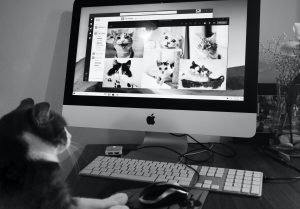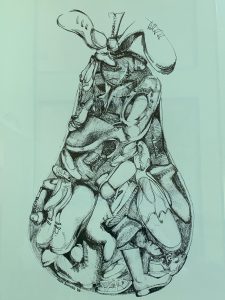“Does this spark joy?” was the question that helped Marie Condo’s methods rise to pop culture prominence. Around me I noticed people responding by examining what was in their closets. I had already been thinking about closets because of what I was observing in my work investigating organizational change, employee culture, and collaboration. While Condo’s concept was a framework for re-assessing the true value of material possessions, I was on a parallel track: analogizing organizational phenomena to items you’d find in a closet. For better or worse, with regard to organizational change, shoes were on my brain! You know the expressions “walk a mile in their shoes,” “follow in their footsteps.” In a similar way organizational dynamics and analogies were cropping up over and over again. Employees’ stories, symptoms, and workplace friction complaints became hard to separate from one company to another.
Organizational Change, Gender and Culture
I like to examine how organizational culture affects our lives. In its research on inclusion and diversity, Accenture found that employees care about culture and look to it as a means of supporting their ability to thrive at work. They found a gendered line where 77 percent of women and 67 percent of men felt culture was “very important” when they were asked to share their perceptions of leaders’ efforts to be more inclusive. The workplace challenges I have observed and known throughout my career have impacted my and others’ abilities to share their full selves, insights, and ideas at work. That is a net loss- whether anyone is measuring that reality or not.
Here is a peek into my closet of phenomena:

Ruby Slippers by rosefirerising. Creative Commons license 2.0.
Employee Ideas: Fuel for Transformation
Ruby Slippers. The best ideas for organizational change and hopefully… improvements often originate with your employees. Tap your “slippers” together three times and make your wish. Just like Dorothy in the Wizard of Oz did not know she had had the power all along to go home until Glenda the Good Witch intervened, the Ruby Slippers represent untapped power within. Tap your organizational heels together three times, your employees may be your hidden superpower.
When you tap people on the front lines and who have a vantage point that is far from your leaders’, their viewpoint and ideas can often be powerful. If you believe you already “listen” to them, does your organization do it more often than in a quarterly or annual survey? When the feedback is gathered by a human, an empathetic and human transaction takes place. Just the act of being listened to by an outside, impartial person sure beats a 4-question Slack-delivered pulse survey. It can also create psychological safety if you couple it with the practice of aggregating feedback into themes (not tied to specific individuals).This candid channel surpasses other methods and supports your organizational change with human aspects.
For one company I worked with, the act of interviewing let people imprint personally on the organizational change process that was being informed by the interviews. By questioning them, the seeds of a new change initiative were being planted. The formation of a Change Advisor Council was the result of some of this work. It could be relied on to both support and advise all future employee initiatives.

Image by Luis Morera.
A Culture Champion in Support of Organizational Change
A few years later, I had the privilege to return to the organization to help advise about a different change initiative being implemented. In speaking to one of the Advisors about his role he said, “Yes, I get paid to have opinions and be critical.” Can you imagine if that organizational energy had not been harnessed by making him an organizational advisor?
When the employee discovery work was done that led to formation of that council, one of the related deliverables was the creation of employee personas that took into account an understanding of the company history and how its rapid growth had impacted company culture and employees’ pride and sense of organizational identity.
Talent Retention: Organize Your Closet with Employee Community

Image by Chris Barbalis
A study by Purdue University about employees’ voluntary turnover efforts found that when you offer ways for your employees to network with each other, the likelihood of turnover (where employees move on to other roles with new companies, is reduced by 140%. Employee communities are a great investment here. A variety of employee community platforms offer digital mechanisms (like a company directory) where individuals can reveal skills and expertise to anyone across the entire organization.
Many employees I have interviewed in big companies talk about their own frustrations in trying to find a company organization chart or directory of who does what. They end up relying on crude tools like Workday and Outlook to find out the basics about others that work there. Who is a subject matter expert in what is one of many great ways to use an employee community. By letting people discover each other, they may be more likely to network internally when they feel the need for a job change.
Wearing the Same Shoes as Your Make for Your Customers

A “Pear” of Shoes by Rafe Bennett
Cobbler’s Children. I hear a lot about how employees see their customers get the latest, greatest tools and technologies and service from their companies. As for the employees chartered with delivering those outstanding customer experiences, things are not…uh…toe to toe. Dr. Ben Dattner, a workplace psychologist calls this Cobbler’s Children Syndrome. I observed this early on in my career talking with customers of the startup I worked for. The social and mobile revolution has only exacerbated all this. Our consumer expectations continue to outstrip the tools and tech offered in the workplace. This can inhibit and hamper organizational change.
While customers are being delivered high-quality experiences that feel like the new and glam shoe on the right…

Image: Luke Hayfield Photography. Creative Commons license 2.0
…employees are expected to provide those experiences using tools, processes or technologies that perform like the shoe on the left. Remember the nursery rhyme about the cobbler’s children? Corporate spending needs to align and support intelligent spending rather than “scorched-earth austerity” approaches. When those who control the budget lose sight of the fact that you must spend money to make money, the shoe becomes an organizational Achilles Heel.
Are You Bubble Wrapped? Leaders Insulated from Organizational Change
What’s in your home utility closet? Tools, supplies, and household materials, perhaps? In my utility closet, I keep bubble wrap to re-use. Because of their position and power, executives need to have teams that will question them and be honest. Without this diversity of input, employees tell me that executive staff can be echo chambers. One insightful person deemed the way some organizations insulate executives as: “bubble wrapped.”
Research done by Accenture about the hidden value of organizational culture makers found that “two thirds of leaders (68 percent) feel they create empowering environments in which, for example, employees can be themselves, raise concerns and innovate without fear of failure. Just one third (36 percent) of employees agree.” I hear about that reality gap. Executives need the self-awareness to recognize that their employee experience may be vastly different from the average employee’s. Their time, attention, and priorities get insulated so they can focus on company priorities.
As organizations get larger and larger, what trickles down changes—sometimes radically. Middle managers aren’t coached on key communications or aren’t advised on their importance. Employees may not be kept in the loop at all. Leaders also lose touch. Employee councils and advocacy groups are a great mechanism to hold space for employee concerns and to counteract the bubble wrapped effect. They also have the benefit of being embodied by employees, and they create direct representation that works in partnership alongside executive leaders and helps to bring an “organizational voice” into the conversation.
Reimagine, Reset and Re-Value Change
Image by Nathan Dumlao.
The lasting effects of the Covid-19 pandemic continue to exert themselves in 2021. Now is a fantastic time for resetting and investigation, and shifting focus to things like culture and new ways to engage employees in the change and improvement process. Partner with them, value their ideas, recognize the originators of those changes and your employees will appreciate renewed efforts to include them. It will bolster their sense of connection with an organization that values their input.

